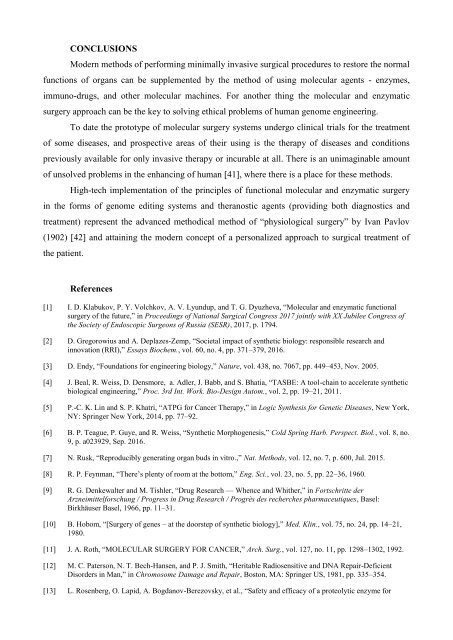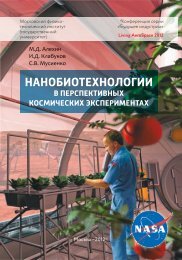Foundations for Molecular and Enzymatic Functional Surgery
This paper presents an approach of molecular and enzymatic surgery for treatment of human diseases, including opportunity for use of systemic biology methods in planning of surgical interventions, possible biological components of a “molecular scalpel”, and problems of standardization, medical ethics and clinical trials of the new pharma-surgical toolbox. In conclusions is proposed to consider of molecular and enzymatic surgery methods as realization of the principles of “functional surgery” and also further development of fast track surgery with attaining the modern concept of a personalized approach to surgical treatment of the patient.
This paper presents an approach of molecular and enzymatic surgery for treatment of human diseases, including opportunity for use of systemic biology methods in planning of surgical interventions, possible biological components of a “molecular scalpel”, and problems of standardization, medical ethics and clinical trials of the new pharma-surgical toolbox. In conclusions is proposed to consider of molecular and enzymatic surgery methods as realization of the principles of “functional surgery” and also further development of fast track surgery with attaining the modern concept of a personalized approach to surgical treatment of the patient.
You also want an ePaper? Increase the reach of your titles
YUMPU automatically turns print PDFs into web optimized ePapers that Google loves.
CONCLUSIONS<br />
Modern methods of per<strong>for</strong>ming minimally invasive surgical procedures to restore the normal<br />
functions of organs can be supplemented by the method of using molecular agents - enzymes,<br />
immuno-drugs, <strong>and</strong> other molecular machines. For another thing the molecular <strong>and</strong> enzymatic<br />
surgery approach can be the key to solving ethical problems of human genome engineering.<br />
To date the prototype of molecular surgery systems undergo clinical trials <strong>for</strong> the treatment<br />
of some diseases, <strong>and</strong> prospective areas of their using is the therapy of diseases <strong>and</strong> conditions<br />
previously available <strong>for</strong> only invasive therapy or incurable at all. There is an unimaginable amount<br />
of unsolved problems in the enhancing of human [41], where there is a place <strong>for</strong> these methods.<br />
High-tech implementation of the principles of functional molecular <strong>and</strong> enzymatic surgery<br />
in the <strong>for</strong>ms of genome editing systems <strong>and</strong> theranostic agents (providing both diagnostics <strong>and</strong><br />
treatment) represent the advanced methodical method of “physiological surgery” by Ivan Pavlov<br />
(1902) [42] <strong>and</strong> attaining the modern concept of a personalized approach to surgical treatment of<br />
the patient.<br />
References<br />
[1] I. D. Klabukov, P. Y. Volchkov, A. V. Lyundup, <strong>and</strong> T. G. Dyuzheva, “<strong>Molecular</strong> <strong>and</strong> enzymatic functional<br />
surgery of the future,” in Proceedings of National Surgical Congress 2017 jointly with XX Jubilee Congress of<br />
the Society of Endoscopic Surgeons of Russia (SESR), 2017, p. 1794.<br />
[2] D. Gregorowius <strong>and</strong> A. Deplazes-Zemp, “Societal impact of synthetic biology: responsible research <strong>and</strong><br />
innovation (RRI),” Essays Biochem., vol. 60, no. 4, pp. 371–379, 2016.<br />
[3] D. Endy, “<strong>Foundations</strong> <strong>for</strong> engineering biology,” Nature, vol. 438, no. 7067, pp. 449–453, Nov. 2005.<br />
[4] J. Beal, R. Weiss, D. Densmore, a. Adler, J. Babb, <strong>and</strong> S. Bhatia, “TASBE: A tool-chain to accelerate synthetic<br />
biological engineering,” Proc. 3rd Int. Work. Bio-Design Autom., vol. 2, pp. 19–21, 2011.<br />
[5] P.-C. K. Lin <strong>and</strong> S. P. Khatri, “ATPG <strong>for</strong> Cancer Therapy,” in Logic Synthesis <strong>for</strong> Genetic Diseases, New York,<br />
NY: Springer New York, 2014, pp. 77–92.<br />
[6] B. P. Teague, P. Guye, <strong>and</strong> R. Weiss, “Synthetic Morphogenesis,” Cold Spring Harb. Perspect. Biol., vol. 8, no.<br />
9, p. a023929, Sep. 2016.<br />
[7] N. Rusk, “Reproducibly generating organ buds in vitro.,” Nat. Methods, vol. 12, no. 7, p. 600, Jul. 2015.<br />
[8] R. P. Feynman, “There’s plenty of room at the bottom,” Eng. Sci., vol. 23, no. 5, pp. 22–36, 1960.<br />
[9] R. G. Denkewalter <strong>and</strong> M. Tishler, “Drug Research — Whence <strong>and</strong> Whither,” in Fortschritte der<br />
Arzneimittel<strong>for</strong>schung / Progress in Drug Research / Progrès des recherches pharmaceutiques, Basel:<br />
Birkhäuser Basel, 1966, pp. 11–31.<br />
[10] B. Hobom, “[<strong>Surgery</strong> of genes – at the doorstep of synthetic biology],” Med. Klin., vol. 75, no. 24, pp. 14–21,<br />
1980.<br />
[11] J. A. Roth, “MOLECULAR SURGERY FOR CANCER,” Arch. Surg., vol. 127, no. 11, pp. 1298–1302, 1992.<br />
[12] M. C. Paterson, N. T. Bech-Hansen, <strong>and</strong> P. J. Smith, “Heritable Radiosensitive <strong>and</strong> DNA Repair-Deficient<br />
Disorders in Man,” in Chromosome Damage <strong>and</strong> Repair, Boston, MA: Springer US, 1981, pp. 335–354.<br />
[13] L. Rosenberg, O. Lapid, A. Bogdanov-Berezovsky, et al., “Safety <strong>and</strong> efficacy of a proteolytic enzyme <strong>for</strong>












